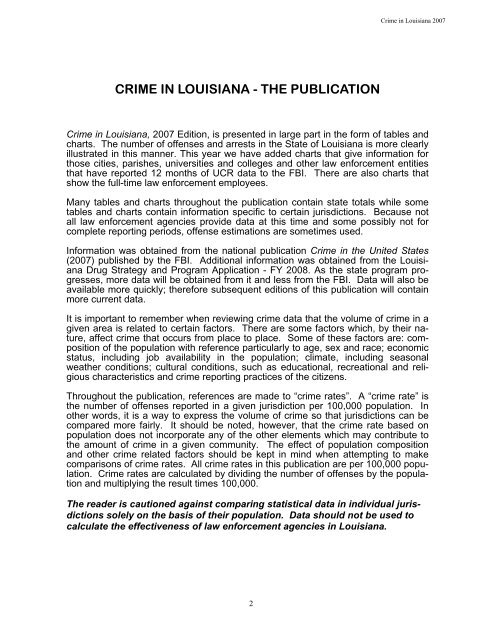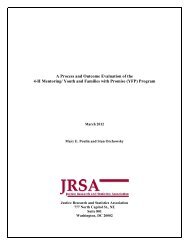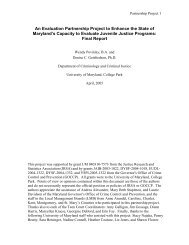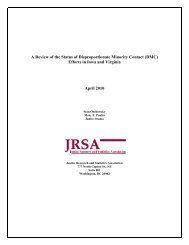Crime in Louisiana 2007 - Justice Research and Statistics Association
Crime in Louisiana 2007 - Justice Research and Statistics Association
Crime in Louisiana 2007 - Justice Research and Statistics Association
Create successful ePaper yourself
Turn your PDF publications into a flip-book with our unique Google optimized e-Paper software.
<strong>Crime</strong> <strong>in</strong> <strong>Louisiana</strong> <strong>2007</strong><br />
CRIME IN LOUISIANA - THE PUBLICATION<br />
<strong>Crime</strong> <strong>in</strong> <strong>Louisiana</strong>, <strong>2007</strong> Edition, is presented <strong>in</strong> large part <strong>in</strong> the form of tables <strong>and</strong><br />
charts. The number of offenses <strong>and</strong> arrests <strong>in</strong> the State of <strong>Louisiana</strong> is more clearly<br />
illustrated <strong>in</strong> this manner. This year we have added charts that give <strong>in</strong>formation for<br />
those cities, parishes, universities <strong>and</strong> colleges <strong>and</strong> other law enforcement entities<br />
that have reported 12 months of UCR data to the FBI. There are also charts that<br />
show the full-time law enforcement employees.<br />
Many tables <strong>and</strong> charts throughout the publication conta<strong>in</strong> state totals while some<br />
tables <strong>and</strong> charts conta<strong>in</strong> <strong>in</strong>formation specific to certa<strong>in</strong> jurisdictions. Because not<br />
all law enforcement agencies provide data at this time <strong>and</strong> some possibly not for<br />
complete report<strong>in</strong>g periods, offense estimations are sometimes used.<br />
Information was obta<strong>in</strong>ed from the national publication <strong>Crime</strong> <strong>in</strong> the United States<br />
(<strong>2007</strong>) published by the FBI. Additional <strong>in</strong>formation was obta<strong>in</strong>ed from the <strong>Louisiana</strong><br />
Drug Strategy <strong>and</strong> Program Application - FY 2008. As the state program progresses,<br />
more data will be obta<strong>in</strong>ed from it <strong>and</strong> less from the FBI. Data will also be<br />
available more quickly; therefore subsequent editions of this publication will conta<strong>in</strong><br />
more current data.<br />
It is important to remember when review<strong>in</strong>g crime data that the volume of crime <strong>in</strong> a<br />
given area is related to certa<strong>in</strong> factors. There are some factors which, by their nature,<br />
affect crime that occurs from place to place. Some of these factors are: composition<br />
of the population with reference particularly to age, sex <strong>and</strong> race; economic<br />
status, <strong>in</strong>clud<strong>in</strong>g job availability <strong>in</strong> the population; climate, <strong>in</strong>clud<strong>in</strong>g seasonal<br />
weather conditions; cultural conditions, such as educational, recreational <strong>and</strong> religious<br />
characteristics <strong>and</strong> crime report<strong>in</strong>g practices of the citizens.<br />
Throughout the publication, references are made to “crime rates”. A “crime rate” is<br />
the number of offenses reported <strong>in</strong> a given jurisdiction per 100,000 population. In<br />
other words, it is a way to express the volume of crime so that jurisdictions can be<br />
compared more fairly. It should be noted, however, that the crime rate based on<br />
population does not <strong>in</strong>corporate any of the other elements which may contribute to<br />
the amount of crime <strong>in</strong> a given community. The effect of population composition<br />
<strong>and</strong> other crime related factors should be kept <strong>in</strong> m<strong>in</strong>d when attempt<strong>in</strong>g to make<br />
comparisons of crime rates. All crime rates <strong>in</strong> this publication are per 100,000 population.<br />
<strong>Crime</strong> rates are calculated by divid<strong>in</strong>g the number of offenses by the population<br />
<strong>and</strong> multiply<strong>in</strong>g the result times 100,000.<br />
The reader is cautioned aga<strong>in</strong>st compar<strong>in</strong>g statistical data <strong>in</strong> <strong>in</strong>dividual jurisdictions<br />
solely on the basis of their population. Data should not be used to<br />
calculate the effectiveness of law enforcement agencies <strong>in</strong> <strong>Louisiana</strong>.<br />
2
















